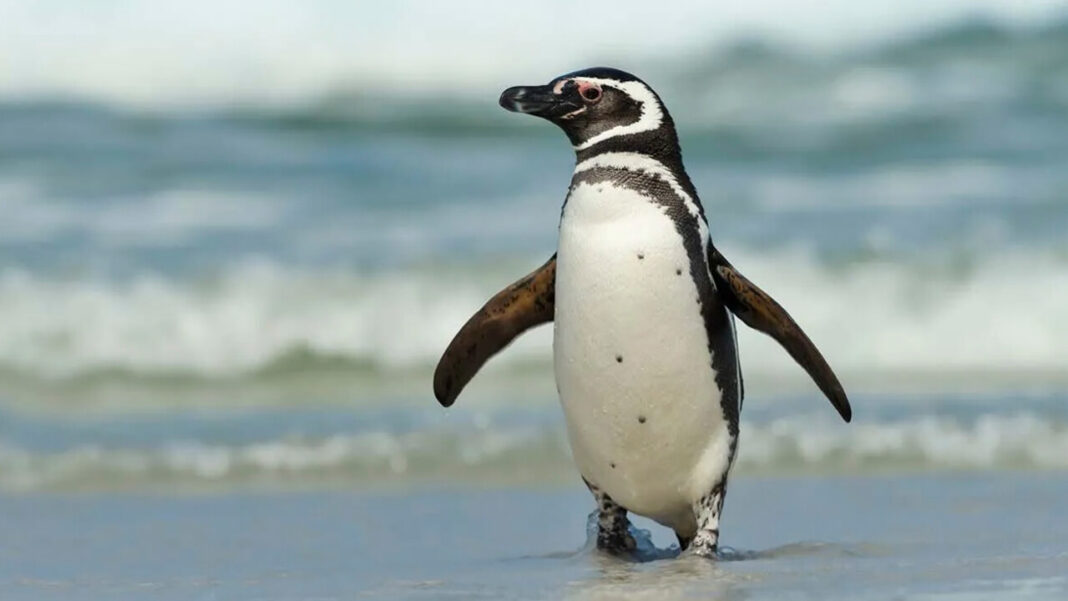Magellanic Penguin
Scientific Classification
| Common Name | Magellanic Penguin |
| Kingdom | Animalia |
| Phylum | Chordata |
| Class | Aves |
| Order | Sphenisciformes |
| Family | Spheniscidae |
| Genus Species | Spheniscus |
Scientific Name
The Magellanic Penguin, also known as the ‘jackass penguin‘ for its braying call, is a species of penguin that lives in South America, particularly in Argentina, Chile, and the Falkland Islands. The scientific name for the Magellanic Penguin is Spheniscus Magellanicus. They are a member of the Spheniscidae family, which includes all penguin species.
Breeding
Magellanic penguins breed in large colonies along the coast, typically in burrows dug into the ground or under bushes. The breeding season typically runs from September to April, with the peak of breeding activity occurring in November and December.
During the breeding season, pairs of penguins form monogamous bonds and work together to build a nest, which is usually a shallow hole lined with pebbles and debris. The female typically lays 2 eggs and both parents take turns incubating the eggs and caring for the chicks. The eggs hatch after about 40 days and the chicks fledge, or leave the nest, at about 55-60 days old.
Magellanic penguins usually raise one brood per year, but if food is abundant, they may raise two broods. The chicks are fed by both parents with regurgitated food.



Penguin Species
Magellanic Penguin Facts And Information
| Type | Bird |
| Description | Magellanic penguins, medium-sized penguins with a black band across the chest, distinctive black and white plumage, and a slightly pinkish-orange patch of skin around their eyes, which becomes more prominent during the breeding season |
| Size | 61 to 76 cm (18-28 in) |
| Weight | 2.7 to 6.5 kg (6.0-14.3 lbs) |
| Diet | Primarily small krill, fish, and squid |
| Incubation | 40-42 days; Magellanic typically lay two eggs during the breeding season, which runs from September to April |
| Sexual Maturity | The average age of sexual maturity is approximately 4 years life |
| e Span | 15-20 years |
| Range | Temperate regions of southern South America |
| Habitat | Nests on cliff faces and grassy shoreline areas |
| Population | Between 1.1 and 1.6 million breeding pairs |
- Magellanic penguins are also known for their braying call, which is how they got their nickname “jackass penguins.”
- The Magellanic is a small species of penguin with a distinctive black band across the chest and a relatively short, thick bill. The back and upper wings are black, while the underparts and lower wings are white.
- These species of penguin are mid-sized, 61 to 76 cm in height, and 2.7 to 6.5 kg in weight.
- They breed along the Atlantic and Pacific coasts of South America, with the largest colonies found in Argentina and Chile, but also adapt to different environments, and have been found breeding on the coast of Brazil, Peru, and the Falkland Islands.
- They are migratory birds and spend the non-breeding season at sea, traveling as far north as Brazil.
- They typically feed on anchovies, sardines, and squid and breed in large colonies along the coast.
- They can fly underwater using their wings to swim.
- Their flippers are relatively short and broad, which makes them excellent swimmers.
- The main source of food is tiny aquatic creatures like krill and small shrimp, but they also eat fish, anchovies, and squids.
- Magellanic penguins typically lay two eggs during the breeding season, which runs from September to April. Both parents take turns incubating the eggs, which usually lasts around 40 days.
- Once the eggs hatch, the chicks are fed by both parents with regurgitated food. The chicks will fledge, or leave the nest, at about 55-60 days old, and will be cared for by their parents for an additional 3-4 weeks.
- The Magellanic Penguin is a popular attraction in zoos and aquariums around the world, where they are often bred in captivity.
- The Magellanic Penguin is one of the most numerous penguin species in the world, with an estimated global population of around 2 million individuals.
- However, their population has decreased in recent years due to human activities such as oil spills, overfishing, and habitat loss.

